Do you know your Isokon from your Ernö Goldfinger? Britain's 10 best Modernist buildings
![De La Warr Pavilion - Tim Winter (Tim Winter (Photographer) - [None]](https://s.yimg.com/ny/api/res/1.2/ODwmqbq3ufoKg77MJhPu7A--/YXBwaWQ9aGlnaGxhbmRlcjt3PTEyNDI7aD03Nzg-/https://media.zenfs.com/en-GB/homerun/the_telegraph_818/c2d0627d7f90273b9c83dd2d2a771890)
Ooh, it lifts the heart, a spot of modernism: light-filled, clean lines, international, uncompromising, pure. Or does it? As the last bits of the Robin Hood Gardens Estate in Poplar fall to the wrecking ball, fans of the mid-century architects Alison and Peter Smithson are gutted - but many residents are chuffed to bits. The V&A has bought a chunk, so you’ll soon be able to judge for yourself.
Meanwhile, if you love a brute of a building, or watch Poirot purely for the streamline moderne, have a look at our favourites from around the UK - and thank the lord for the Modernist Society and the Twentieth Century Society.
1. Midland Hotel, Morecambe
It’s white, it’s bright and it sits on a promontory overlooking mighty Morecambe Bay: the Midland Hotel is all-out 1930s glamour, an elegant curve of it, with two wings, a glass-walled central stair and dazzling sun terrace. It was designed by two Modernist superstars, Oliver Hill (exterior) and Eric Gill (interior) on the site of a traditional Victorian railway hotel, but that didn’t save it from decline in the late 1990s. It was rescued by Urban Splash and reopened as a hotel in 2008. Book the Gill Suite, which still has his incised map of Lancashire and the Lake District on the wall.
Entrance: If you don’t want to stay, turn up for tea on the sun terrace (1-2.45pm, 3.15-5.30pm; £21 per person, £24.50 with prosecco).
Stay: In the Midland itself, of course, with views over the sweep of the bay (doubles from £140pn B&B; telegraph.co.uk/tt-the-midland-hotel).
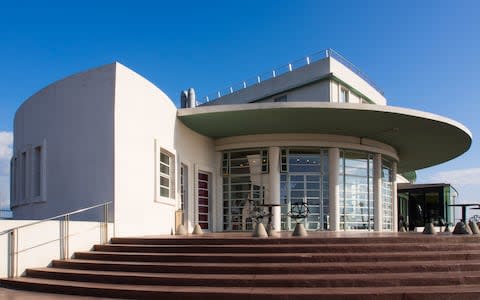
2. Silver End Village, Braintree
In the late 1920s, Francis Henry Crittal, whose company, Crittal Windows, supplied millions of homes across Britain, wished to build a factory and housing for his workers. He chose Silver End, south-east of Braintree, commissioning the Scottish architect Thomas S Tait (who also designed the Telegraph’s old Fleet Street home, Peterborough Court) to create a moderne village: you can still see his work on Silver Street and Francis Way, the primary academy still uses his school building with its huge windows and, despite demolition in 2008, a couple of factory buildings survive.
Entrance: Free, but before you go look at the Silver End Heritage Society website so that you can perhaps time your visit with one of their Open Days (usually on Saturday mornings).
Stay nearby: Drive 12 miles to the Flitch of Bacon, a restaurant with rooms in Little Dunmow, home village of the chef Daniel Clifford (doubles from £80pn B&B; (telegraph.co.uk/tt-the-flitch-of-bacon-hotel).
3. Isokon Building, Belsize Park
This glorious 1934 apparition of white cement-washed reinforced concrete, with its horizontal lines and cantilevered exterior landings and stairs, looks like a cruise liner landlocked in Belsize Park, north London. Originally called the Lawn Road Flats, it was built for Jack and Molly Pritchard, whose design firm was called Isokon, by the Japan-born, Canada-based British architect Wells Coates, who was deeply influenced by Le Corbusier. Such is the interest in the building that it has its own gallery.
Entrance: The Isokon Gallery opens at weekends from 11am to 4pm (Mar-Oct; free entry but donations welcome).
Stay nearby: The Haverstock Hotel in nearby Belsize Park is rocking a little contemporary deco itself (doubles from £89 pn B&B; haverstockhotel.co.uk).
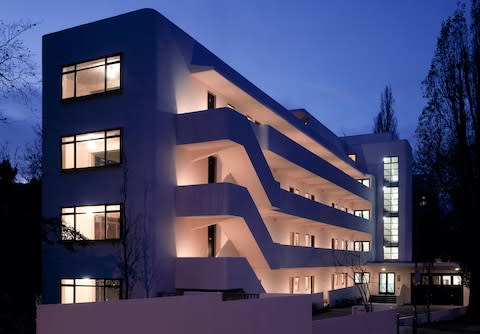
4. Craigsbank Church, Corstorphine
The influence of Le Corbusier’s Ronchamp chapel shows in every line of this dazzlingly simple 1960s church in a suburb west of Edinburgh. The architect, Sir William Kininmonth, took local inspiration from the Covenanters who used to meet near the city in hilltop hollows, designing a rectangular building cupped in curved walls. Inside there is a sunken nave, raked timber pews sweeping down to the altar and daylight pouring in from a skylight grid. A white cross hovers over white walls.
Entrance: Craigsbank is a Church of Scotland church, holding services every Sunday at 11am. Look out for openings during Scotland’s Doors Open Days every September.
Stay nearby: The Dakota Edinburgh Hotel, north west of Corstorphine, is a nod to the golden age of deco (it’s named after the stylish aeroplane) marooned in a retail park in Ferrymuir, south of the Forth Bridge. Handy for the airport, bridge and train to the city (from £77 pn B&B; telegraph.co.uk/tt-dakota-edinburgh-hotel).
5. De La Warr Pavilion, Bexhill on Sea
Another jolly seaside construction, the De La Warr Pavilion was built as a cultural centre in 1935. The name comes from the ninth Earl De La Warr, who initiated the design competition won by Erich Mendelsohn and Serge Chermayeff (German and Russian respectively), and after a long period in the doldrums it had a triumphant re-opening in 2005. Go for the lively programme of exhibitions and shows, for its café, its glorious sun terrace, light-filled stairwell and genuine community atmosphere.
Entrance: Free entry with ticketed exhibitions and events (dlwp.com).
Stay nearby: The Driftwood Hotel, around the corner, is small, friendly and run by an Austrian chef - expect knudl, speck and schniztel (from £79 pn B&B; telegraph.co.uk/tt-the-driftwood-hotel).
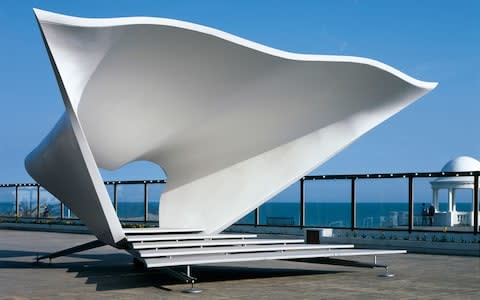
6. Preston Bus Station
When this 557ft-long building opened in 1969 it was Europe’s biggest bus station, with glass-walled passenger halls, bays for 80 buses and multi-storey car parking on top. Its immensely long, finned decks resemble a gigantic car radiator. It survived, partly thanks to the 20th Century Society, and its 2018 refurbishment by John Puttick Associates retained original details including iroko timber seats and Pirelli rubber floors.
Entrance: Tickets please. It’s a working bus station, go and use it - and imagine the days when everyone was genuinely excited about using the nearby M6 (johnputtickassociates.com).
Stay nearby: The Stanley Hotel & Spa, Mellor, is a Grade-II listed country manor seven miles outside Preston (doubles from £140pn; telegraph.co.uk/tt-stanley-house-hotel-and-spa).
7. Two Willow Road, Hampstead
This utterly simple horizontal building in brick and concrete, now in the care of the National Trust, was the home that the Hungarian émigré architect Ernö Goldfinger built for his family in 1939, decades before he built the brutalist Balfron and Trellick Towers. It has a wall of windows on the first floor, filling the rooms with light: here he entertained everyone from Henry Moore to Julian Huxley. The design is softened by timber floors, podiums and screens and the elegant, slender spiral staircase.
Entrance: The house re-opens on 2 March 2019 (11am to 5pm, Wednesday to Sunday until 2 November 2019; National Trust members free; nationaltrust.org.uk/2-willow-road).
Stay nearby: Treat yourself to the Great Northern Hotel at King’s Cross Station and hop on the Northern Line to Hampstead Underground Station, a 10-minute walk from Willow Road (doubles from £197 pn; telegraph.co.uk/tt-great-northern-hotel).
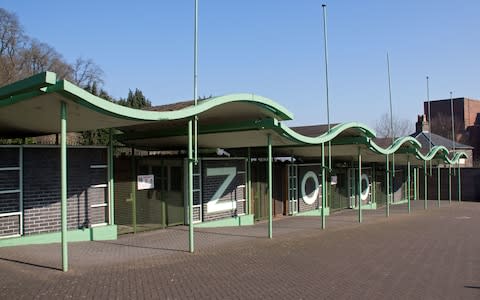
8. Dudley Zoo Tectons
This is one of Britain’s biggest architectural surprises: 12 Tectons – the largest collection in the world – inside Dudley Zoo, built in the late 1930s as a state-of-the-art housing for animals. The Tecton Group, founded by another émigré, Bertholt Lubetkin, already had form with the double-spiral Penguin Pool at London Zoo. Sadly, the Tectons don’t reach contemporary standards for animals, but they have – almost miraculously – survived and undergone recent refurbishment. There can be few cheerier sights than the five interlocking canopies of the entrance saying ‘ZOO’.
Entrance: The zoo is open daily except Christmas Day (10am to 3pm in winter; adults £16.50, children £10.50; dudleyzoo.org.uk/tectons).
Stay nearby: Stay Cool is a collection of 35 rental apartments in Birmingham’s Rotunda, built as office space in 1965 and rescued by Urban Splash. It’s 30 minutes’ drive from Dudley or 10 minutes from New Street to Dudley and Sandwell railway station, though you’ll need a taxi to the zoo (from £99 pn for a mini-studio B&B; telegraph.co.uk/tt-staying-cool-hotel).
9. Jubilee Pool, Penzance
Splash! What a thrill when this glamorous, streamlined saltwater lido, designed by the borough architect in the 1930s right on the promenade at Penzance, reopened in the spring of 2016. It has always had strong local support from the Jubilee Pool Association and it was transferred to community ownership in 2017. Next year it will reopen with new geothermal facilities, so that it can be used year-round.
Entrance: Open daily 10.30am to 6pm, until 7pm Tuesdays (adults £5, juniors and concessions £3.50, families from £7.50, under-4s free; jubileepool.co.uk ).
Stay nearby: The Chapel Hotel, a Georgian townhouse with six rooms and light-filled drawing room, is in the middle of Penzance, 10 minutes’ walk from the lido (double from £150 pn; telegraph.co.uk/tt-Chapel-House-Penzance-hotel).
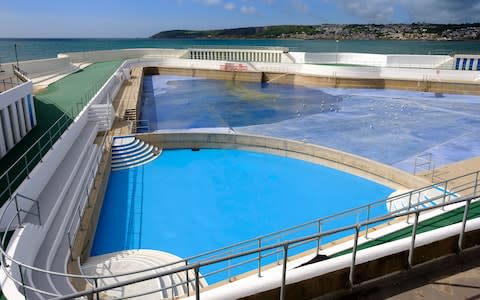
10. Renold Building, Manchester
W A Gibbon’s 1962 academic building, with its tower, podium and external stairwell, is part of the former University of Manchester Institute of Science and Technology (UMIST) campus, an extraordinary cluster of Modernist buildings. Go quickly: it’s now known as the Sackville Street campus and faces a 20-year redevelopment by the university. The Renold has a wall of long, east-facing faceted windows – according to Eddy Rhead of the Modernist Society ‘people got cooked in summer’ and some had to be blacked out – and it has a surviving Victor Pasmore mural inside.
Entrance: Near Manchester Piccadilly railway station, not far from Oxford Road and open to the public (c20society.org.uk)
Stay nearby: The Staycity Aparthotels Manchester Piccadilly is on the other side of the station from Sackville Street (one-bed apartments from £97, excluding breakfast; telegraph.co.uk/tt-staycity-aparthotels-manchester-piccadilly-hotel).


